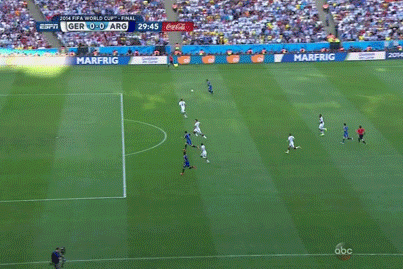Explaining what is the offside rule in soccer - with Gifs and Images
If you're new to the game, you're probably
thinking that this is a dreadful rule and that it's no way you can figure it
out.
However, the truth is that the offside rule is
fairly easy to understand and pretty straightforward.
It was created to make the game more tactical,
with fewer goals.
Imagine if the striker could simply wait near
the opponent's goal post and ask for the ball to score. Wouldn't that be
boring?
Frankly, I tried to read several articles about
how the offside rule works, when and where it applies during a match, I even
looked at the official FIFA explanatory article on the subject, but it all left
me even more puzzled. So, I can sympathize with your confusion.
So, I wondered how a beginner is supposed to
grasp the concept of the offside rule when reading such nonsense?
That's why I had to shed some light on the
subject to try to reduce its complexity a bit. Or at least try to.
The origin of the offside rule:
First, let's talk history. The offside rule
originated in 1863 and states that a player is considered offside if three
players from the opposing team are in front of him (including the goalkeeper).
Crazy, huh?
Later, it was changed in 1990 to what we know
today, which is that a player is onside if he is within the distance of the
second to last player of the opposing team (including the goalkeeper).
The rule was originally created by the Europeans
to stop the Brazilian team who had very skilled players who could sneak
pinpoint long balls behind the opponent's defense and score goals like
hotcakes.
It was a trick to stop Brazil in the 1960's...
which obviously failed since to this day the Brazilian national team is the
most crowned team in World Cup history.
When a soccer player is considered offside?

Observe how at the moment the pass was released
from the playmaker's foot (in this case Sergio Ramos), the attacker (Cristiano
Ronaldo) was behind the last defender, so there was no one between him and the
goalkeeper, hence the play is clearly offside.
Think of it this way, you
can't ask for the ball when you are behind the last opposing defender. At the
moment the ball is released from your teammate's foot - the moment of impact -
your entire body must be in the same line (or in front) of the last defender.
Yes, it's that simple. There
is one special case, though, we will take a look at it right away.
What is VAR?
As if soccer didn't have enough controversy. FIFA has introduced video assistant referees, known as VAR. Basically, there is a team of referees somewhere in the stadium watching the game through several cameras.
The principle goes like this: If the referee misses a decision, the video assistant can step in to clear up the situation with a video replay, and allow the referee to correct his or her decision.
But because not all countries have the resources and facilities to implement VAR, it is not yet widely used.
Is there an exception to the offside rule?
I just said that if you are behind the last defender when the pass is released for your teammate's foot - it's always caught offside... Well, I lied.
There is one exception and that is if the pass goes to the back. Let me explain... If your teammate is in front of you when he/she makes the pass - no matter where the last defender or goalkeeper is - it's never offside. Check out the gif here.
In conclusion...
All the theories and explanations will be of no use to you if you don't get used to watching live games and important matches with high intensity. Soccer, or as the whole world refers to it, football, is a simple game with many laws. Yes, there are no rules in soccer but instead, there are laws.





Comments
Post a Comment